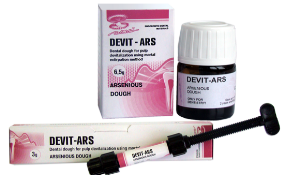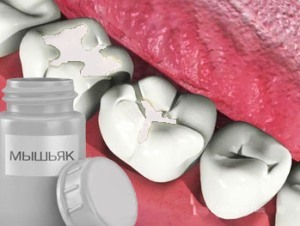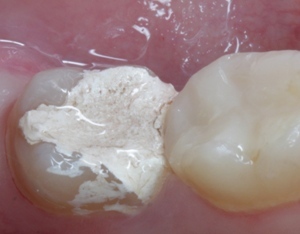 Removal of pulp requires killing it. To this end, arsenic to the tooth is used - a time-tested remedy that is still used in dentistry, despite the variety of anesthetics of the new generation.
Removal of pulp requires killing it. To this end, arsenic to the tooth is used - a time-tested remedy that is still used in dentistry, despite the variety of anesthetics of the new generation.
It's quite difficult to work with arsenic. Minor deviations in dosage and exposure time can lead to undesirable consequences.
Contents of
- Why and for what are arsenic deposited?
- Treatment procedure
- How does arsenic look like in the examples?
- How long can I keep?
- How much can I keep a child?
- Danger of using the drug in dentistry
- How to remove the healing paste from the tooth yourself?
- Should the tooth ache during treatment, and what if it hurts?
- Why does the tooth on which arsenic is put on pain?
Why and for what do they put arsenic?
The drug is known as a potent toxic substance of high hazard class. Necrotizing pastes based on arsenic are used in those situations when the use of modern anesthetics is impossible.  Most often, this occurs in two cases: allergic reactions to anesthetic drugs and, if necessary, an emergency dental treatment that requires nerve killing.
Most often, this occurs in two cases: allergic reactions to anesthetic drugs and, if necessary, an emergency dental treatment that requires nerve killing.
Arsenic destroys the vascular bundle in the tooth, thereby killing the pulp. Pastes with it also contain anesthetic agents, thanks to which the process of necroticisation of the nerve passes painlessly.
Treatment procedure
Nerve removal using arsenic-based formulations is carried out in two stages. First, the dentist performs an autopsy of the carious cavity. Necrotic tissues are removed, and the inner surface of the tooth is cleaned. In the resulting cavity, the dentist enters the paste with arsenic. A temporary seal is placed on top, and the patient leaves home.
 The duration of the composition is determined by the physician. At the second stage of treatment, the temporary filling is removed, the paste containing arsenic is removed, the tooth walls are cleaned. Preparations typically include color pigments. The remainder of the dye on the walls of the tooth indicates an incomplete removal of the paste from the cavity.
The duration of the composition is determined by the physician. At the second stage of treatment, the temporary filling is removed, the paste containing arsenic is removed, the tooth walls are cleaned. Preparations typically include color pigments. The remainder of the dye on the walls of the tooth indicates an incomplete removal of the paste from the cavity.
Before performing an operation to extract the nerve, the dentist must be sure that the traces of arsenic have been removed from the carious cavity. Depulpation is completely painless, because at the time of surgery the nerve is completely dead.
Usually, after the treatment, the patient is assigned radiography, which is necessary in order to make sure of the positive results of treatment.
How does arsenic look like in the examples?

In the photo, arsenic in the tooth, closed with a temporary seal
It is unlikely that you will be able to see arsenic, because it is hidden by a temporary seal. If it falls out, you need to make sure that the arsenic-based paste is not in the open cavity. It is advisable to rinse the mouth with a soda solution with the addition of iodine. The open cavity should be plugged with a cotton or gauze ball and in the shortest possible time to see a doctor.
Determine the presence of a paste with arsenic in the mouth can be by color. Usually blue dye is added to the dental composition. The presence of coloring pigments on the required treatment of the tooth indicates the presence of arsenic, which should be removed. If the paste is not found, then it is possible that it could be swallowed. It's not necessary to panic because of this. The concentration of toxic substance in the dental paste is not too high. To neutralize its effect, is recommended to drink a glass of milk .
How long can I keep?
The duration of arsenic exposure to pulp depends on the complexity of the treatment. The average period during which the necrosis of the pulp should occur is two days. When removing the nerve on a single-root tooth, arsenic kills the nerve in the tooth during for 24 hours of .The maximum time of use of arsenic paste is 3 days .
How much can you keep a child?
 In the treatment of infant teeth, the time of exposure to arsenic is corrected. Usually it is 16-24 hours.
In the treatment of infant teeth, the time of exposure to arsenic is corrected. Usually it is 16-24 hours.
Overdose arsenic in the tooth is dangerous to health. Among the most common complications in the abuse of arsenic paste:
- darkening of the dentin;
- intoxication of the body;
- medication periodontitis;
- pulpal edema;
- necrosis of periosteum.
The dangers of using the drug in the dentistry
In modern dentistry arsenic is used infrequently and the fault is that serious side effects and a lot of contraindications, among which:
-
 allergic reactions to the components of the drug;
allergic reactions to the components of the drug; - child's age;
- strong curvature of tooth channels;
- increased intraocular pressure;
- kidney disease;
- violation of root integrity.
Arsenic is practically not used for the removal of pulp in pregnant women, since the effect of the drug on the fetus has not been fully studied.
With high sensitivity to the components of the dental makeup, there may be abnormalities in the gastrointestinal tract and liver.
In pediatric dentistry it is used extremely rarely and only if there are fully formed dental roots.
More on the pros and cons:
How to remove the healing paste from the tooth yourself?
Doctors do not recommend taking the medicine away on their own, especially since this is quite problematic, but there are situations when there is no other way out. This happens when emergency treatment is necessary, and dental clinics do not work because of holidays or holidays. Once away from civilization, you also have to get rid of arsenic yourself. Remove arsenic should be and in the event that a temporary seal flew out. So how can this be done?
 If there is a seal, it can be removed with a normal sewing needle or nozzle from the syringe. As a rule, the compositions for temporary fillings are not particularly hard. If the seal has flown out itself, it is necessary to extract the arsenic paste with the same needle or tweezers previously treated with alcohol. Mouth it is desirable to rinse with a solution of with the addition of iodine or hydrogen peroxide .Open cavity must be covered with a cotton swab.
If there is a seal, it can be removed with a normal sewing needle or nozzle from the syringe. As a rule, the compositions for temporary fillings are not particularly hard. If the seal has flown out itself, it is necessary to extract the arsenic paste with the same needle or tweezers previously treated with alcohol. Mouth it is desirable to rinse with a solution of with the addition of iodine or hydrogen peroxide .Open cavity must be covered with a cotton swab.
Do not delay with a visit to the doctor. In the absence of qualified dental care, the risk of developing inflammatory processes and the possibility of complications increase dramatically.
Should the tooth ache during treatment, and what if it hurts?
How much does the tooth ache after the temporary filling with the healing paste? If the arsenic paste is applied correctly, the tooth should not hurt. First, because the composition of the drug contains anesthetic components. Secondly, necrosis of the nerve contributes to a complete loss of sensitivity in the tooth.
Why does the tooth on which arsenic was put on pain?
-
 preparation is applied to closed pulp;
preparation is applied to closed pulp; - allergic reactions;
- inadequate drug concentration;
- inflammation of the peri-toothed tissues;
- drug overdose.
Toothache in treatment should not be tolerated in any case. The presence of pain indicates serious problems that can have unpleasant consequences for the patient. Do not use anesthetics yourself.
First, it is difficult to determine their compatibility with the components of arsenic paste. Secondly, the arsenic drug itself is a powerful anesthetic, and if it does not work, then you should not look for an even more powerful painkiller, but to identify the problem that the toothache signals.
